 Alves encouraged her design students in Maputo to have fun with typography. Photos: Barbara Alves
Alves encouraged her design students in Maputo to have fun with typography. Photos: Barbara Alves Portuguese communication designer Barbara Alves arrived in Mozambique in 2009 to work with the Theater of the Oppressed Maputo, a branch of a community activist group she had been involved with in Lisbon. There she developed projects that led participants to question their roles in society, for example by creating identities and positions for imagined political parties using tape as their only visual material. Alves went on to work with students at ENAV, Mozambique’s National School of Visual Arts. Her Design and the City workshops inspired students to clean, beautify and improve the safety of downtown Maputo. Back in Lisbon, Alves spoke to Vera Sacchetti of Change Observer about Mozambique’s transforming design culture.
Vera Sacchetti
What’s the design scene like in Mozambique?
Barbara Alves
It’s hard for me to characterize. In terms of commercial practice, most of the designers are Portuguese. Their firms deal with the most important cultural clients and largest companies, especially South African stakeholders. Major campaigns are very similar to the ones you find in Europe, with special attention given to music, lyrics, street slang, dance and body language. National identity is commonly used to market products. For example, Mozambique is compared to South Africa and Brazil, and its image — with emphasis on traditional dance, timbale, chicken, matapa [a local dish based on collard greens] and beer — is “sold” as the most artistic in Africa.
Mozambique is a very young country. Even though it gained independence from Portugal in 1975, civil war lasted until 1992, and only since then have Mozambicans had the opportunity to create their country. People are extremely proud of their nationality. The flag is a meaningful symbol they relate to; its depiction of a machine gun crossed with a hoe on an open book stands for ideals they believe in firmly: the fight for independence, education and knowledge, the possibility to cultivate one’s land and feed everyone. The flag’s colors are present in many design materials, and politics are visible in daily life in images, logos, graffiti, and the printed motifs on the beautiful capulanas — rectangles of cloth used by women for garments, hats, towels, suitcases, bed linens, to carry babies, etc.
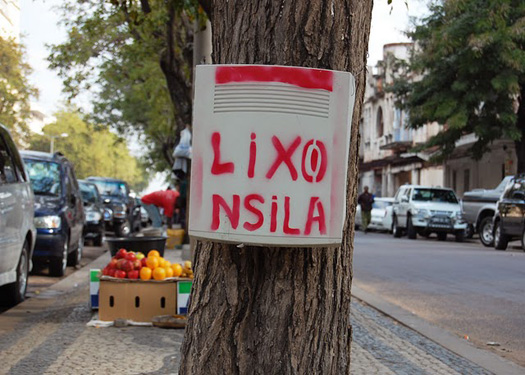 ENAV students created public garbage bins from discarded computer cases. Lixo means "trash" in Portuguese. Nsila is the translation in Changana, the local dialect.
ENAV students created public garbage bins from discarded computer cases. Lixo means "trash" in Portuguese. Nsila is the translation in Changana, the local dialect. Sacchetti
How was your experience as a teacher in Mozambique?
Alves
Education has been at a very low level, but is rapidly improving. All around Mozambique, I admired how much people believed in schooling as a tool to fight poverty and construct a new life. In Maputo, I met many people who held more than one job and studied early in the morning or after work.
During Portuguese colonialism, there was no interest in providing a proper education. After independence, the war affected society on all levels, and for years people finished school without even knowing how to read. Classes can have around 70 students; sometimes people don’t have the money to pay the birth registration needed to enroll children in school. Books are scarce, and I saw many schools outside Maputo with a blackboard hanging on a tree and children sitting on the ground. But I witnessed efforts in improving the quality of education around the country.
It’s interesting to see that although people appreciate their very rich culture, they do not connect its traditions to contemporary knowledge and practices. For example, students in the graphic design course I taught at ENAV asked me to give them lessons in color, insisting they knew nothing about it. This really surprised me. My immediate answer was, “But you should teach me! You’re surrounded by color and use it in such powerful ways in every aspect of daily life. I admire you for it!” Their response was to laugh and say, “But Teacher! That’s not design! We need to use design colors.” From talking to my students and people in the cultural sector, I got the impression that design was this distant, quite artificial, field they had to adapt to. Their main concern is learning software. Still a lot has to be done in understanding the value of design thinking. Design is not thought of in terms of concepts, processes or ideas connected to daily life.
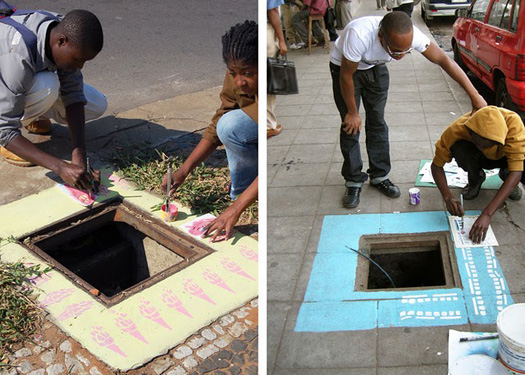 In Alves's "Signalization and the City" workshop, students painted patterns around the many dangerous, deep holes found throughout downtown Maputo.
In Alves's "Signalization and the City" workshop, students painted patterns around the many dangerous, deep holes found throughout downtown Maputo. Sacchetti
How did you work on broadening their perspective of design?
Alves
One thing I did, and I know other teachers are doing, was introducing people to social networks to establish international connections. I encouraged them to use search engines to be less dependent on bad libraries and expensive books, and to create blogs and publish and discuss their ideas, life and work. Maybe this will shorten the distance people feel to other educational systems and cultures.
Of course, Mozambican designers exist, but often with no training in the field. Some of them are studying law or economics. Until last September, the only existing design school was ENAV, a vocational arts high school. The new ISAC (Institute for Art and Culture) presents the first opportunity for graduate education in design.
Both schools are now part of international networks that support teacher-exchange programs, improve educational facilities and staff and provide resources like computers and a silkscreen studio. Schools are transforming, but there’s room for more change. My feeling is that sometimes initiatives do not succeed because locals aren’t involved, or aren’t made responsible for change as much as they can be. When the process of building new structures isn’t inclusive enough, efforts can be short-lived. But there is a very positive vibe in these schools; my hope is that a critical view and discussion will drive this development in Mozambique.
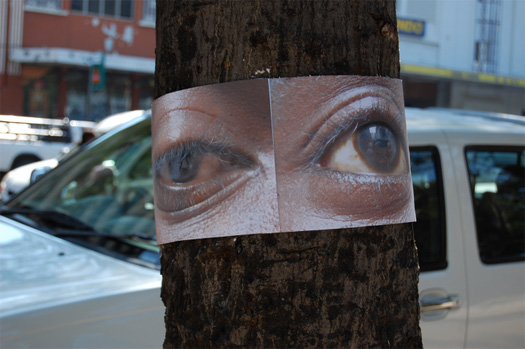 For a project to discourage men from urinating on trees, the students arrived at the idea of making the act feel as public as possible.
For a project to discourage men from urinating on trees, the students arrived at the idea of making the act feel as public as possible.Sacchetti
What kind of projects did you lead?
Alves
In one of my workshops at ENAV, Design and the City–Projecto Zona, I asked students to address problems they found right in the neighborhood. We talked about design as a thinking process as well as a process of interacting with people and the environment — how it could be used to draw attention, give visibility, shape public opinion and create solutions. We also discussed the degree of social responsibility to which designers can choose to commit.
The response to my workshop left me amazed. I had the feeling that something just clicked. In the streets of downtown Maputo, people who were convinced that the students were working for the government often asked them what they were up to. When the students explained, their questioners were at first suspicious, then surprised, and finally congratulatory. They applauded them for intervening and expressed hope that their efforts would shame politicians into becoming more responsible. In Maputo, you don’t feel that the state has any interest in maintaining an urban infrastructure; these students were proud to take an active role, and, realizing their power, wanted to do more.
I had been teaching at a university for six years previous to this workshop and am used to following students’ work and making what I believe are good suggestions and critiques. This project challenged me; I had to be quite firm sometimes to keep the ideas within realistic money constraints and to push the students to complete the work on schedule. But apart from my initial input — offering feedback to the concepts and leading group discussion — I stepped back. I realized that by trying to organize them, I was interfering too much. As it turned out, while I thought they were being chaotic and seemed distracted, they were really highly productive. Fun needed to be part of work and irony part of dealing with life.
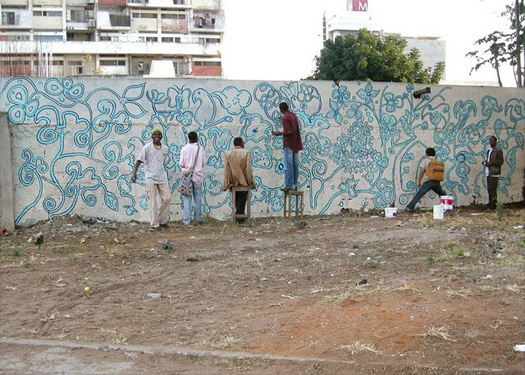 Transforming an unpleasant vacant lot into a public space.
Transforming an unpleasant vacant lot into a public space.Sacchetti
Have you had a chance to follow up with them?
Alves
They emailed me to say that they’ve kept on working and I’ll have a surprise when I go back later this month. I’m very curious to see what it is.
Sacchetti
You mentioned the lack, until recently, of formal design education in Mozambique, but what about the many untrained people who make things from scraps of materials and are generally described as tinkerers or bricoleurs? What role do they have?
Alves
The bricoleur idea of design exists everywhere in Mozambique. It is fundamental to survival. With a large percentage of the population living below the poverty line, the creation of objects does not express a conscious vision of the world, but the need to create solutions with cheap and easy-to-find materials. People simply reuse, reimagine and reshape their surroundings to fit their needs. They recycle and fix things constantly, and have done so since they were very young. Children create all kinds of toys from leftover materials, and adults adapt objects to create utensils they need. Some of these are creative, beautiful solutions. You find them everywhere — from a bottle opener to a shoe. I collected photos of chairs that had been repaired to the extent that they had become new designs and were being used by guards all around the city. The guards were surprised at my interest. My feeling is that people are not conscious of their design accomplishments. They solve problems, wishing they could buy some new stuff like they see on TV.
It will be very interesting to see what happens when these problem-solving skills are used not only in repairing broken objects, but also in creating something new, with a consciousness of the creative process. I am also curious to see what happens when people collaborate on a common project, exchanging ideas. Mozambicans still do not see design as an added value in their daily life or in their economies.
Sacchetti
Looking back, how do you feel about your experience in Mozambique?
Alves
From my first visit, I never counted on how much my time in the country would challenge me. The context was so different that it was complicated for me to understand my own conscience and values. Was it good or bad to act? What were my real expectations toward “helping”? Why did I think I could help? Or should? What’s good, what’s right? How to analyze work in this context? Why was I really there? How did I feel as a Portuguese there? Could I forget it? Or must I not? I still don’t know how to talk about Mozambique, or what I think in many circumstances. Ideas are flowing and changing, and it is very difficult to have a perspective.
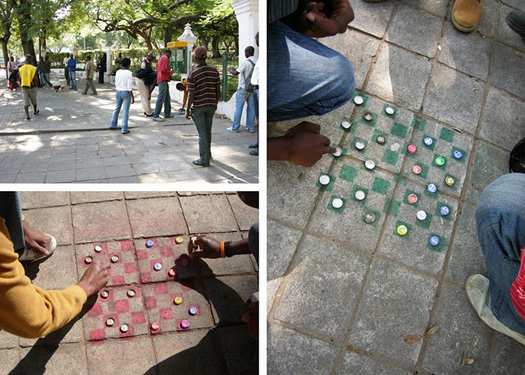 Turning the sidewalks into recreational spaces.
Turning the sidewalks into recreational spaces.Sacchetti
What are you currently working on?
Alves
I am now preparing a project about language diversity and communication. In Mozambique, 41 languages are spoken besides the official language, Portuguese, the mother tongue of only 6 percent of the population. Thirty-seven and a half percent of these speakers live in Maputo. Because people have migrated there from around the country, a variety of languages co-exist in the capital city now: Xichangana (spoken by 27 percent of the urban population), Xirhonga (8.4 percent), Cicopi (2.9 percent), Gitonga (2.5 percent), Xitshwa (3 percent) and other Bantu languages (3.9 percent). In informal situations, people use mainly Xichangana to communicate; they reserve Portuguese for official situations and school and use their mother tongue at home. Most people are bilingual or trilingual. The proximity of Mozambique to South Africa has created a strong English-language influence, introducing many loanwords in everyday language, such as estou biz (I'm busy), vou jobar (I'm going to work/my job), essa hei-de deletar (I'll delete that). Portuguese is the only language whose writing is taught; in other languages, orthography is unstable, and it is common for people to discuss different ways of spelling a word. This freedom allows language to be used in a surprisingly creative way.
I once asked a group of students in Maputo to help me translate "community" from Portuguese to Xichangana. This simple question generated a long debate. By translating the word, the students negotiated their different perspectives on what community means.
Visual and written communication in Maputo does not reflect this linguistic diversity. Most of these communications are in Portuguese, and are incomprehensible to the majority of residents not only because of the language barrier, but also because of cultural differences. Of course, designers create image-based solutions, but this has also been problematic, as such variety produces different interpretations. These questions are of extreme importance in a country where it is essential to communicate messages related to preventing AIDS, cholera, malaria, and those that give information on hygiene and human rights.
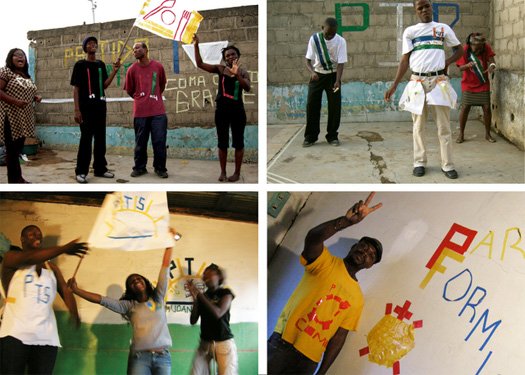 For a workshop with the Theatre of the Oppressed Maputo, Alves asked participants to develop their own political parties and platforms and to defend them. Their only material was tape.
For a workshop with the Theatre of the Oppressed Maputo, Alves asked participants to develop their own political parties and platforms and to defend them. Their only material was tape. 